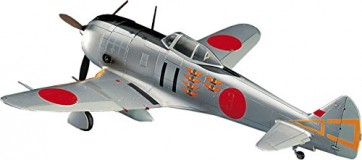-20%
Hasegawa 1/48 Nakajima Nakajima Ki-44 type Ⅱ Hei Shoki japan NEW
Availability: In Stock
Regular Price: ¥2,400
Special Price ¥1,920
Details
Details
Plastic / Aircraft Model Assembly Kit
● In 1943, when the soldiers' thought shifted from light fighting fighting to high-speed blow-off tactics, the Army emphasized speed, lift, and descent performance at almost the same time as the prototype issuance of light-fighting key -43 We issued an instruction to prototype high-speed heavy fighter plane -44 to Nakajima.
● Nakajima chooses a high-powered engine to satisfy the army's requirement and decided to Ha-41 with the largest output at that time, the nose became thicker and the wing became thicker as the main wing became faster to increase the wing area Smaller thanks to the outrage and adopted a unique butterfly flap at the rear wing of the main wing to enhance the performance during air battle and takeoff and landing.
● As a result of the test, the poor visibility at takeoff and landing and poor stability at low speed, the pilots familiar with the Ninety - seven type fighter were embarrassed reputation was not good.
● However, in the performance comparison with Bf - 109E and Kawasaki Kei - 60, because the key was superior to that of the B - 109E and Kawasaki Ke - 60, it was adopted as a two - type single seat fighter in 1972 and later named the name "Jong - zhu" . The aircraft equipped with Ha -41 distinguished it from the two-type single-fighter aircraft type 1, and the aircraft carrying the more powerful engine H-109 from the two-type single-seat fighter aircraft type ii.
● Also, there are A, B, B and C due to arms and equipment differences in Nichido, 1,227 aircraft are produced in total between 1945 and 1949, active in intercepting enemy bombers about air defense duties Did.
● In 1943, when the soldiers' thought shifted from light fighting fighting to high-speed blow-off tactics, the Army emphasized speed, lift, and descent performance at almost the same time as the prototype issuance of light-fighting key -43 We issued an instruction to prototype high-speed heavy fighter plane -44 to Nakajima.
● Nakajima chooses a high-powered engine to satisfy the army's requirement and decided to Ha-41 with the largest output at that time, the nose became thicker and the wing became thicker as the main wing became faster to increase the wing area Smaller thanks to the outrage and adopted a unique butterfly flap at the rear wing of the main wing to enhance the performance during air battle and takeoff and landing.
● As a result of the test, the poor visibility at takeoff and landing and poor stability at low speed, the pilots familiar with the Ninety - seven type fighter were embarrassed reputation was not good.
● However, in the performance comparison with Bf - 109E and Kawasaki Kei - 60, because the key was superior to that of the B - 109E and Kawasaki Ke - 60, it was adopted as a two - type single seat fighter in 1972 and later named the name "Jong - zhu" . The aircraft equipped with Ha -41 distinguished it from the two-type single-fighter aircraft type 1, and the aircraft carrying the more powerful engine H-109 from the two-type single-seat fighter aircraft type ii.
● Also, there are A, B, B and C due to arms and equipment differences in Nichido, 1,227 aircraft are produced in total between 1945 and 1949, active in intercepting enemy bombers about air defense duties Did.
Additional Info
Additional Info
| Manufacturer | HASEGAWA |
|---|---|
| Weight (kg) | 0.3800 |
| Release Date | No |
| Series | No |
| Package Depth (mm) | 290 |
| Package Height (mm) | 180 |
| Package Width (mm) | 50 |
Reviews
Tags








